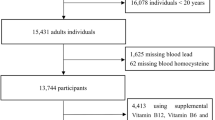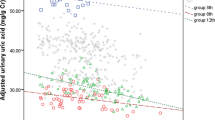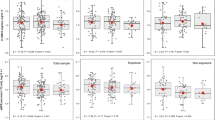Abstract
There is growing evidence that cardiovascular health can be affected by exposure to methylmercury (MeHg), by a mechanism involving oxidative stress. Paraoxonase 1 (PON1) is a high-density lipoprotein-bound enzyme that hydrolyzes toxic oxidized lipids and protects against cardiovascular diseases. Evidence from in vitro studies indicates that MeHg can inhibit PON1 activity but little is known regarding this effect in humans. We investigated whether increased blood mercury levels are associated with decreased serum PON1 activity in Cree people who are exposed to MeHg by fish consumption. We conducted a multi-community study of 881 Cree adults living in Eastern James Bay communities (Canada). Multivariate analyses considered sociodemographic, anthropometric, clinical, dietary and lifestyle variables and six PON1 gene variants (rs705379 (−108C/T), rs662 (Q192R), rs854560 (L55M), rs854572 (−909C/G), rs854571 (−832C/T) and rs705381 (−162C/T)). In a multiple regression model adjusted for all potential confounding factors and the rs854560 PON1 variant, a statistically significant MeHg*rs705379 interaction was observed. Blood mercury levels were inversely associated with serum PON1 activities in individual homozygous for the −108T allele (P=0.009). Our results suggest a gene–environment interaction between the rs705379 polymorphism and MeHg exposure on PON1 activity levels in this aboriginal population. This finding will need to be replicated in other population studies.
This is a preview of subscription content, access via your institution
Access options
Subscribe to this journal
Receive 6 print issues and online access
$259.00 per year
only $43.17 per issue
Buy this article
- Purchase on Springer Link
- Instant access to full article PDF
Prices may be subject to local taxes which are calculated during checkout


Similar content being viewed by others
References
Goyer R, Vasken Apshian H, Arab L, Bellinger D, Burbacher T, Burke T et al. Toxicological Effects of Methylmercury. National Academy Press: Washington DC. 2000.
Clarkson TW, Magos L . The toxicology of mercury and its chemical compounds. Crit Rev Toxicol 2006; 36: 609–662.
Roman HA, Walsh TL, Coull BA, Dewailly E, Guallar E, Hattis D et al. Evaluation of the cardiovascular effects of methylmercury exposures: current evidence supports development of a dose-response function for regulatory benefits analysis. Environ Health Perspect 2011; 119: 607–614.
Salonen JT, Seppanen K, Nyyssonen K, Korpela H, Kauhanen J, Kantola M et al. Intake of mercury from fish, lipid peroxidation, and the risk of myocardial infarction and coronary, cardiovascular, and any death in eastern Finnish men. Circulation 1995; 91: 645–655.
Costa LG, Cole TB, Jarvik GP, Furlong CE . Functional genomics of the paraoxonase (PON1) polymorphisms: effects on pesticide sensitivity, cardiovascular disease, and drug metabolism. Annu Rev Med 2003; 54: 371–392.
Watson AD, Berliner JA, Hama SY, La Du BN, Faull KF, Fogelman AM et al. Protective effect of high density lipoprotein associated paraoxonase. Inhibition of the biological activity of minimally oxidized low density lipoprotein. J Clin Invest 1995; 96: 2882–2891.
Bhattacharya T, Nicholls SJ, Topol EJ, Zhang R, Yang X, Schmitt D et al. Relationship of paraoxonase 1 (PON1) gene polymorphisms and functional activity with systemic oxidative stress and cardiovascular risk. JAMA 2008; 299: 1265–1276.
Mackness B, Hine D, Liu Y, Mastorikou M, Mackness M . Paraoxonase-1 inhibits oxidised LDL-induced MCP-1 production by endothelial cells. Biochem Biophys Res Commun 2004; 318: 680–683.
Mackness B, Durrington P, McElduff P, Yarnell J, Azam N, Watt M et al. Low paraoxonase activity predicts coronary events in the Caerphilly Prospective Study. Circulation 2003; 107: 2775–2779.
Shih NA, Xia YR, Wang XP, Miller E, Castellani LW, Subbanagounder G . Combined serum paraoxonase knockout/apolipoprotein E knockout mice exhibit increased lipoprotein oxidation and atherosclerosis. J Biol Chem 2000; 275: 17527–17535.
Costa LG, Cole TB, Furlong CE . Paraoxonase (PON1): from toxicology to cardiovascular medicine. Acta Biomed 2005; 76 (Suppl 2): 50–57.
Furlong CE, Suzuki SM, Stevens RC, Marsillach J, Richter RJ, Jarvik GP et al. Human PON1, a biomarker of risk of disease and exposure. Chem Biol Interact 2010; 187: 355–361.
Mackness B, Mackness MI, Arrol S, Turkie W, Durrington P . Effect of the human serum paraoxonase 55 and 192 genetic polymorphisms on the protection by high density lipoprotein against low density lipoprotein oxidative modification. FEBS 1998; 423: 57–60.
Aviram M, Billecke S, Sorenson R, Bisgaier C, Newton R, Rosenblat M et al. Paraoxonase active site required for protection against LDL oxidation involves its free sulfhydryl group and is different from that required for its arylesterase/paraoxonase activityes: selective action of human paraoxonase allozymes Q and R. Arterioscler Thromb Vasc Biol 1998; 18: 1617–1624.
Brophy VH, Jarvik GP, Richter RJ, Rozek LS, Schellenberg GD, Furlong CE . Analysis of paraoxonase (PON1) L55M status requires both genotype and phenotype. Pharmacogenetics 2000; 10: 453–460.
Brophy VH, Hastings MD, Clendenning JB, Richter RJ, Jarvik GP, Furlong CE . Polymorphisms in the human paraoxonase (PON1) promoter. Pharmacogenetics 2001; 11: 77–84.
Brophy VH, Jampsa RL, Clendenning JB, McKinstry LA, Jarvik GP, Furlong CE . Effects of 5′ regulatory-region polymorphisms on paraoxonase-gene (PON1) expression. Am J Hum Genet 2001; 68: 1428–1436.
Costa LG, Vitalone A, Cole TB, Furlong CE . Modulation of paraoxonase (PON1) activity. Biochem Pharmacol 2005; 69: 541–550.
Gonzalvo CM, Gil F, Hernandez AF, Villanueva E, Pla A . Inhibition of paraoxonase activity in human liver microsomes by exposure to EDTA, metals and mercurials. Chem Biol Interact 1997; 105: 169–179.
Gencer N, Arslan O . Purification human PON1Q192 and PON1R192 isoenzymes by hydrophobic interaction chromatography and investigation of the inhibition by metals. J Chromatogr B Analyt Technol Biomed Life Sci 2009; 877: 134–140.
Ayotte P, Carrier A, Ouellet N, Boiteau V, Abdous B, Laouan Sidi EA et al. Relation between methylmercury exposure and plasma paraoxonase activity in Inuit adults from Nunavik. Environ Health Perspect 2011; 119: 1077–1083.
Khan M, Wang F . Mercury-selenium compounds and their toxicological significance: toward a molecular understanding of the mercury-selenium antagonism. Environ Toxicol Chem 2009; 28: 1567–1577.
Pouliot M, Despres J, Lemieux S, Moorjani S, Bouchard C, Tremblay A et al. Waist circumference and abdominal sagittal diameter: best simple anthropometric indexes of abdominal visceral adipose tissue accumulation and related cardiovcascular risk in men and women. Am J Cardiol 1994; 73: 460–468.
Friedewald WT, Levy RI, Fredrickson DS . Estimation of the concentration of low-density lipoprotein cholesterol in plasma, without use of the preparative ultracentrifuge. Clin Chem 1972; 18: 499–502.
Deakin S, Guernier S, James RW . Pharmacogenetic interaction between paraoxonase-1 gene promoter polymorphism C-107T and statin. Pharmacogenet Genomics 2007; 17: 451–457.
Deakin S, Leviev I, Brulhart-Meynet MC, James RW . Paraoxonase-1 promoter haplotypes and serum paraoxonase: a predominant role for polymorphic position -107, implicating the Sp1 transcription factor. Biochem J. 2003; 372 (Pt2): 643–649.
Rodgers JS, Hocker JR, Hanas RJ, Nwosu EC, Hanas JS . Mercuric ion inhibition of eukaryotic transcription factor binding to DNA. Biochem Pharmacol 2001; 61: 1543–1550.
Ansell BJ, Navab M, Hama S, Kamranpour N, Fonarow G, Hough G et al. Inflammatory/antiinflammatory properties of high-density lipoprotein distinguish patients from control subjects better than high-density lipoprotein cholesterol levels and are favorably affected by simvastatin treatment. Circulation 2003; 108: 2751–2756.
Cakatay U, Kayali R, Uzun H . Relation of plasma protein oxidation parameters and paraoxonase activity in the ageing population. Clin Exp Med 2008; 8: 51–57.
Cherki M, Berrougui H, Isabelle M, Cloutier M, Koumbadinga GA, Khalil A . Effect of PON1 polymorphism on HDL antioxidant potential is blunted with aging. Exp Gerontol 2007; 42: 815–824.
Rainwater DL, Rutherford S, Dyer TD, Rainwater ED, Cole SA, Vandeberg JL et al. Determinants of variation in human serum paraoxonase activity. Heredity 2009; 102: 147–154.
Jaouad L, de Guise C, Berrougui H, Cloutier M, Isabelle M, Fulop T . Age-related decrease in high-density lipoproteins antioxidant activity is due to an alteration in the PON1's free sulfhydryl groups. Atherosclerosis 2006; 185: 191–200.
Aviram M, Billecke S, Sorenson R, Bisgaier C, Newton R, Rosenblat M et al. Paraoxonase active site required for protection against LDL oxidation involves its free sulfhydryl group and is different from that required for its arylesterase/paraoxonase activities: selective action of human paraoxonase allozymes Q and R. Arterioscler Thromb Vasc Biol 1998; 18: 1617–1624.
Mackness B, Mackness M, Arrol S, Turkie W, Julier K, Abuasha B et al. Serum paraoxonase (PON1) 55 and 192 polymorphism and paraoxonase activity and concentration in non-insulin dependent diabetes mellitus. Atherosclerosis 1998; 139: 341–349.
Abbot CA, Mackness M, Kumar S, Boulton AJM, Durrington PN . Serum paraoxonase activity, concentration, and phenotype distribution in diabetes mellitus and its relationship to serum lipids and lipoproteins. Atheroscler ThrombVasc Biol 1995; 15: 1812–1818.
Acknowledgements
This scientific communication is a report from the Nituuchischaayihtitaau Aschii Multi-Community Environment-and-Health Longitudinal Study in Iiyiyiu Ashii supported by the Cree people of Northern Quebec, the Cree First Nations and the Cree Board of Health and Social Services of James Bay through financial contributions from Niskamoon Corporation. We gratefully acknowledge the support of the Natural Sciences and Engineering Research Council of Canada’s Metals in the Human Environment Strategic Network. A complete list of sponsors is available at http://www.ncbi.nlm.nih.gov/pubmed/20077280. We also acknowledge the support of FRQS Environmental Health Research Network.
Author information
Authors and Affiliations
Corresponding author
Ethics declarations
Competing interests
The authors declare no conflict of interest.
Rights and permissions
About this article
Cite this article
Drescher, O., Dewailly, E., Diorio, C. et al. Methylmercury exposure, PON1 gene variants and serum paraoxonase activity in Eastern James Bay Cree adults. J Expo Sci Environ Epidemiol 24, 608–614 (2014). https://doi.org/10.1038/jes.2013.96
Received:
Revised:
Accepted:
Published:
Issue Date:
DOI: https://doi.org/10.1038/jes.2013.96



